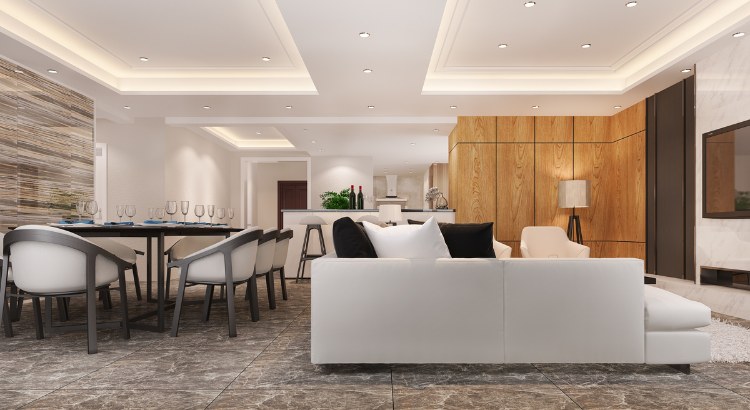The new trend in interior design is one that breaks away from the norm — exposed basement ceilings. This new look questions ideas of what a secret place is and inspires us to reevaluate the possibilities in space up there.
“Stay Open-Minded about Exposed Basement Ceilings” is not just a hint; it’s an investigation of unexplored architectural areas. Exposing structural elements deliberately change a normal space to an art canvas.
So, in this blog, we’ll unravel the practicability of this trend and show that an open mind is one of the keys to opening doors of wowing and turning your basement into a one-of-a-kind style and functionality center.

What Does a Basement’s Exposed Ceiling Mean?
A basement exposed ceiling is an example of a design idea that goes beyond conventional ideas of hidden interiors. This style purposefully displays structural elements like pipes, ductwork, and beams rather than hiding them, giving the space a raw, industrial look.
An exposed basement ceiling creates a new perspective on the space above by opting not to conceal what is usually hidden.
Different Designs and Variations

The adaptability of open basement ceilings is what makes them so beautiful. Homeowners can customize the appearance to suit what they like with the help of numerous styles and variants.
The design options are many, ranging from an industrial and rustic feel with exposed metal ducts to a more minimalist look with painted pipes and beams.
Homeowners can showcase their individual design preferences in their basements by utilizing exposed ceiling types and variants, which can range from embracing an unfinished, raw aesthetic to adding elegant accents.
Discover your options and see how a ceiling that is exposed may completely change the feel of your basement.
Is an Exposed Ceiling Allowed in a Finished Basement?
Choosing an open ceiling in a finished basement offers a sleek, industrial feel while challenging conventional architectural conventions. This style emphasizes exposed architectural features, such as beams and ducting, which give the room a distinctive and roomy vibe.
Although homeowners value the ease of repair, there could be negative effects, such as decreased insulation and increased noise.
When choosing an exposed ceiling for their completed basement, homeowners should carefully evaluate what they prefer and seek professional advice because it’s important to strike a balance between design and functionality.
Pros of an Open Basement Ceiling
Maintained Ceiling Height
An open basement ceiling maintains the room’s height, making it feel more roomy and airy and contributing to the overall comfort and spaciousness of the area.
Fast Recovery
Choosing an uncovered ceiling cuts down on building time greatly, enabling the basement to be finished and used quickly without having to wait for lengthy construction timetables.
Simple Accessibility
The open ceiling design makes maintenance needs easy to reach, allowing homeowners to take care of problems quickly and affordably. This accessibility is especially useful for any future renovations or utility repairs.
Better Lighting
The basement can make the most of natural light by having an open ceiling, which will make the space feel lighter and cozier. The exposed structure also makes inventive lighting solutions possible, which improves the room’s overall aesthetic appeal.
Cons for Exposing a Basement Ceiling
There are a number of drawbacks to having a basement ceiling exposed, including increased noise from mechanical systems, possible problems with insulation that could result in energy waste, and the requirement for careful design integration to preserve the space’s overall aesthetic coherence.
It is important to balance usefulness and style when thinking about this design option.
Addressing Possible Drawbacks
Considered Noise
Foot movement on the upper levels or noise from mechanical systems may be amplified by exposed ceilings. This problem can be resolved by adding carpets or other sound-absorbing materials, which will keep the finished basement quieter.
Insulation Issues
Poor insulation from exposed ceilings may result in inefficient use of energy. Insulated panels and spray foam insulation applied to exposed surfaces can assist in controlling temperature and reduce energy loss in order to address this.
Aesthetic Balance
It is important to strike a balance between the desired aesthetic harmony with the rest of the property and the industrial charm of an open ceiling.
While keeping the desired open style, using decorative features like strategically placed decor or set lighting fixtures can improve the overall visual appeal.
Which Colour Works Best for an Open Basement Ceiling?
The overall design plan and intended atmosphere must be taken into consideration when choosing the perfect color for an open basement ceiling.
Choosing a neutral color, such as light gray or white, can brighten the area and give the impression of being clean and large. Darker colors, like charcoal or black, give off an air of drama and industry.
The optimal color selection ultimately comes down to the homeowner’s choice in design, the amount of natural light in the room, and how well the color blends in with the rest of the basement’s interior.
Black Painted Open Basement Ceilings

A black-painted open basement ceiling offers a striking industrial feature and a modern, stylish look. The strong contrast created by the dark color highlights the exposed structural features.
Even though black ceilings provide a contemporary touch to a room, it’s important to take into account the natural light in the area as well as the overall design plan.
Although black ceilings can seem cozier, they may also require more lighting to maintain a well-balanced ambiance.
White Painted Open Basement Ceilings

White paint on exposed basement ceilings creates a fresh, airy, and roomy ambience. This timeless option reflects light, giving the room an air of spaciousness and coziness.
Ceilings painted white provide a flexible background that easily fits into a variety of design themes.
This color scheme works particularly well in basements with low natural light levels since it brightens the space and gives it an open, spacious feeling.
Best Way to Paint a Basement Exposed Ceiling
- The exposed ceiling should be primed and cleaned.
- Select a paint that is well-coated and of high quality.
- Think about choosing a color that goes well with the room’s decor.
- Using a roller or sprayer, evenly apply the paint.
- As you paint, make sure there is enough ventilation.
- For a seamless and secure application, take the appropriate safety measures.
Ideas and Techniques for a Professional Finish
- Give the surface a thorough cleaning and smoothing.
- Invest in top-notch materials and tools to achieve excellent outcomes.
- Use appropriate methods that are suited to your particular project.
- For a polished appearance, pay attention to color harmony and design coherence.
- Avoid hurrying the procedure; a polished finish requires patience.
- Keep up with the latest methods and fashions in your industry.
- Put precision first to achieve a polished result.
- Make sure the surface is well-primed and conditioned.
- Before beginning the entire task, practice and refine your technique on a smaller scale.
- Look to expert work for inspiration and modify it to fit your own style.
Which Type of Lighting Is Best for Basement Rafters?

Making a well-lit and aesthetically pleasing environment in a basement with exposed rafters requires careful consideration of lighting options.
For a contemporary and industrial look, think about hanging track lighting or pendant lights in between the rafters. Another good choice that maintains the open ceiling style while offering uniform illumination is recessed lighting.
A soft, energy-efficient glow is added by integrating LED strips along the rafters, which improves the atmosphere overall. A peaceful and welcoming ambiance is guaranteed when the lighting is customized to your personal style and functional requirements.
Exposed Ceiling Beams

The rustic charm and architectural character of interior spaces are enhanced by exposed ceiling beams. Frequently composed of wood, these structural components provide a space with a feeling of coziness and realness while serving as a visually captivating center point.
Exposed ceiling beams add a light and airy feel to any space, whether it’s a modern loft, a traditional farmhouse, or a lovely cottage.
They can be painted to blend in with the general architectural scheme or left in their natural form to display the workmanship of the building.
A design decision that blends stylistic and structural components and adds to a space’s overall appeal is the presence of exposed ceiling beams.
Conclusion
In conclusion, realizing the full potential of a home’s bottom level requires keeping an open mind about exposed basement ceilings.
Despite being unusual, these exposed elements present a special opportunity for design, turning an often-overlooked element into a feature that is both eye-catching and fashionable.
Depending on personal preference, embracing the raw and industrial look can provide either a cozy, rustic atmosphere or a modern, urban one. It’s also a sensible decision because exposed basement ceilings are a cost-effective option.
Homeowners can transform the basement into a flexible and visually captivating area that challenges convention and improves the overall character of the house by redefining existing conceptions.




